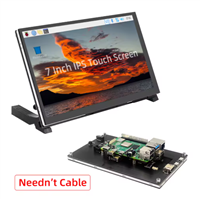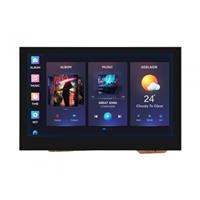
|
KiCADKicad
|
|
|
|
Rust |
Neotron Pico
The Neotron Pico is designed to run the Neotron OS - a CP/M or MS-DOS alike OS written in Rust. But, being open-hardware, you can program your Neotron Pico to do pretty much anything.
The Raspberry Pi Pico is the core of the Neotron Pico. It uses PIO statemachines to generate 12-bit Super VGA video, and digital 16 bit 48 kHz stereo audio. It also has both I2C and SPI buses. SPI chipselects and IRQs are handled by an SPI-to-GPIO expander. This provides eight chip-selects and eight IRQs, to support up to eight expansion slots or peripherals. The eight chip-selects can be globally disabled, allowing the Pico to talk to either the I/O exander, or the selected expansion slot. The board has an SD Card fitted in the 'Slot 1' position, and the Board Management Controller in the 'Slot 0' position, leaving 'Slot 2' through to 'Slot 7' available for expansion. Each expansion slot has both I2C and SPI, along with unique chip-select and IRQ signals.
This project exists because modern computers are too complicated for beginners to understand, but educational kits are often based around very old processors like the Z80 which can’t be programmed in modem programming languages like Rust.
Specs
- Dual Cortex-M0+
- One dedicated for video/audio
- One available for OS/Application use
- 264 KiB SRAM
- 2 MiB Boot ROM
- Micro-ATX form-factor
- SD Card slot for storage
- 12V DC input
- SPI and I2C based expansion bus
- Four externally accessible expansion slots
- Debug headers with signals for two more slots
- Dual PS/2 ports for Keyboard + Mouse
- 16-bit 48 kHz stereo audio headphone out, line out, line in, and microphone in
- 12-bit (4096 colour) VGA video output
- Capable of 40x25, 80x25 and 80x50 text modes
- Capable of 640x480 @ 60 Hz 16-colour, 320x240 @ 60 Hz / 300x200 @ 70 Hz 256-colour graphics modes
- Designed to run the Neotron OS
- Open Source Hardware
- Designed for hand assembly
Components in detail
Processor
The main processor module is the Raspberry Pi Pico, which features:
- A Raspberry Pi Silicon RP2040 SoC
- Dual-core Cortex-M0+ @ 133 MHz
- 264 KiB internal SRAM
- No internal Flash
- USB 1.1
- SPI, UART, I2C and Programmable I/O peripherals
- 26 GPIO pins
- 2 MiB QSPI Flash
- On-board LED
- On-board 5V to 3.3V regulator
- USB 2.0 Full-speed OTG micro-AB port
- 4.00 USD / 3.60 GBP retail price
- The limited I/O on the Pico (we are using half the available pins just for the video output) is supplemented using a Microchip MCP23S17 SPI to GPIO expander, and an 3:9 decoder. See the I/O Expanders section for more details.
Neotron Pico
*PCBWay community is a sharing platform. We are not responsible for any design issues and parameter issues (board thickness, surface finish, etc.) you choose.

Raspberry Pi 5 7 Inch Touch Screen IPS 1024x600 HD LCD HDMI-compatible Display for RPI 4B 3B+ OPI 5 AIDA64 PC Secondary Screen(Without Speaker)
BUY NOW
ESP32-S3 4.3inch Capacitive Touch Display Development Board, 800×480, 5-point Touch, 32-bit LX7 Dual-core Processor
BUY NOW
Raspberry Pi 5 7 Inch Touch Screen IPS 1024x600 HD LCD HDMI-compatible Display for RPI 4B 3B+ OPI 5 AIDA64 PC Secondary Screen(Without Speaker)
BUY NOW- Comments(1)
- Likes(4)
 Log in to post comments.
Log in to post comments.
 Mitch AltmanFeb 03,20230 CommentsReply
Mitch AltmanFeb 03,20230 CommentsReply
-
 Andrew Brady
Dec 14,2024
Andrew Brady
Dec 14,2024
-
 Stefan Karlsson
Sep 17,2023
Stefan Karlsson
Sep 17,2023
-
 DT-Electronics
Oct 03,2022
DT-Electronics
Oct 03,2022
-
 NOEL benoit
Sep 14,2022
NOEL benoit
Sep 14,2022
- 1 USER VOTES
- YOUR VOTE 0.00 0.00
- 1
- 2
- 3
- 4
- 5
- 6
- 7
- 8
- 9
- 10
- 1
- 2
- 3
- 4
- 5
- 6
- 7
- 8
- 9
- 10
- 1
- 2
- 3
- 4
- 5
- 6
- 7
- 8
- 9
- 10
- 1
- 2
- 3
- 4
- 5
- 6
- 7
- 8
- 9
- 10

-
9design
-
8usability
-
8creativity
-
9content
 More by Jonathan Pallant
More by Jonathan Pallant
-
-
-
Modifying a Hotplate to a Reflow Solder Station
858 1 5 -
MPL3115A2 Barometric Pressure, Altitude, and Temperature Sensor
444 0 1 -
-
Nintendo 64DD Replacement Shell
376 0 2 -
V2 Commodore AMIGA USB-C Power Sink Delivery High Efficiency Supply Triple Output 5V ±12V OLED display ATARI compatible shark 100W
1093 4 2 -
How to measure weight with Load Cell and HX711
692 0 3















































